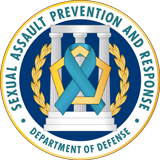Welcome to CATCH!
The CATCH Program gives people making a sexual assault report, where the name of the suspect is not known by law enforcement, an opportunity to anonymously submit suspect information to help the Department of Defense identify serial offenders. For more information, contact your local Sexual Assault Response Coordinator (SARC) or Victim Advocate (VA). To locate a SARC or VA near you, click here.
For general questions about the CATCH Program, contact SAPRO.
For CATCH website IT support, contact 571-305-9999, option 2 (SARCs only, not victims.)
For Victims: |
|||
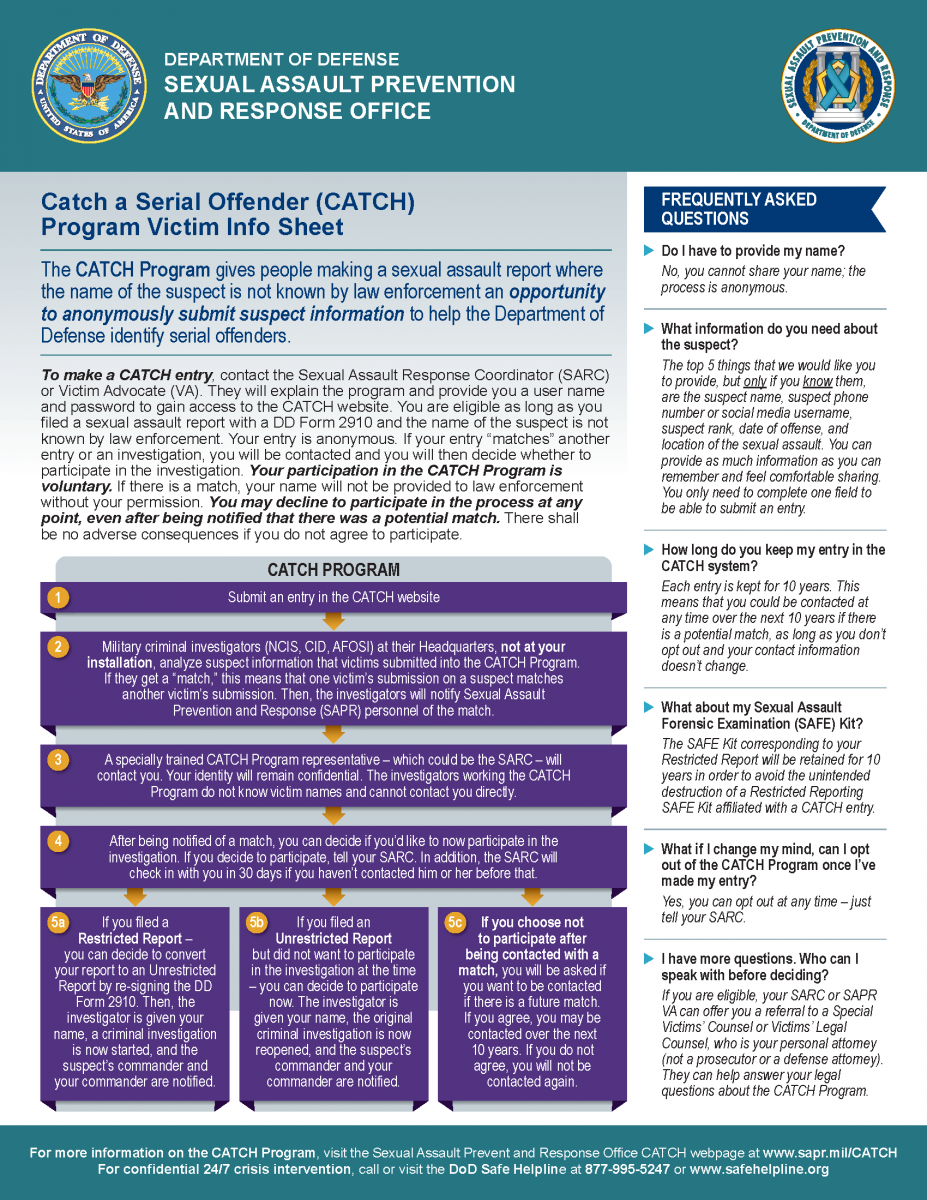 |
|||
| Victim Info Sheet for CATCH Program
Inform sexual assault victims about the CATCH Program, how it works, and provide additional resources. |
CATCH Entry Form
Review a sample CATCH entry form. |
Pocket Card for victims with CATCH Timeframes
Print our cards to provide victims with CATCH login information. |
|
For SARCs: |
|||
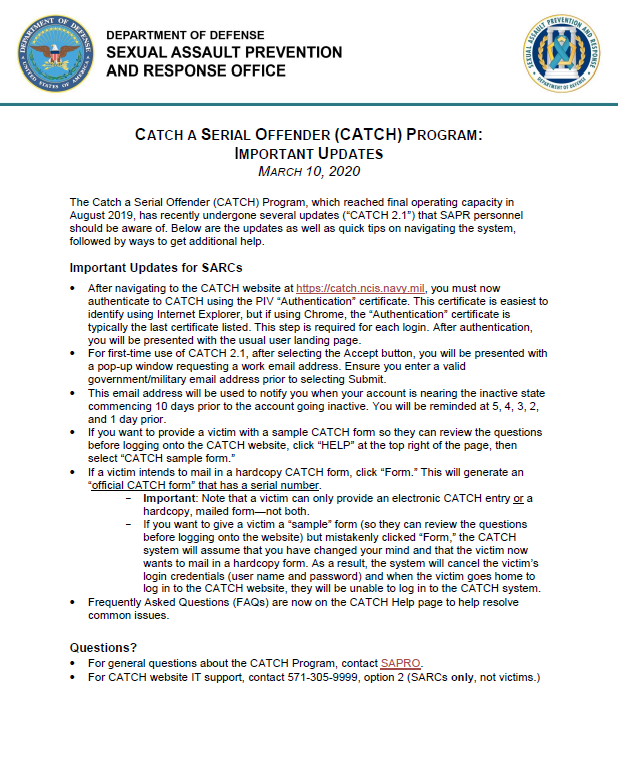 |
 |
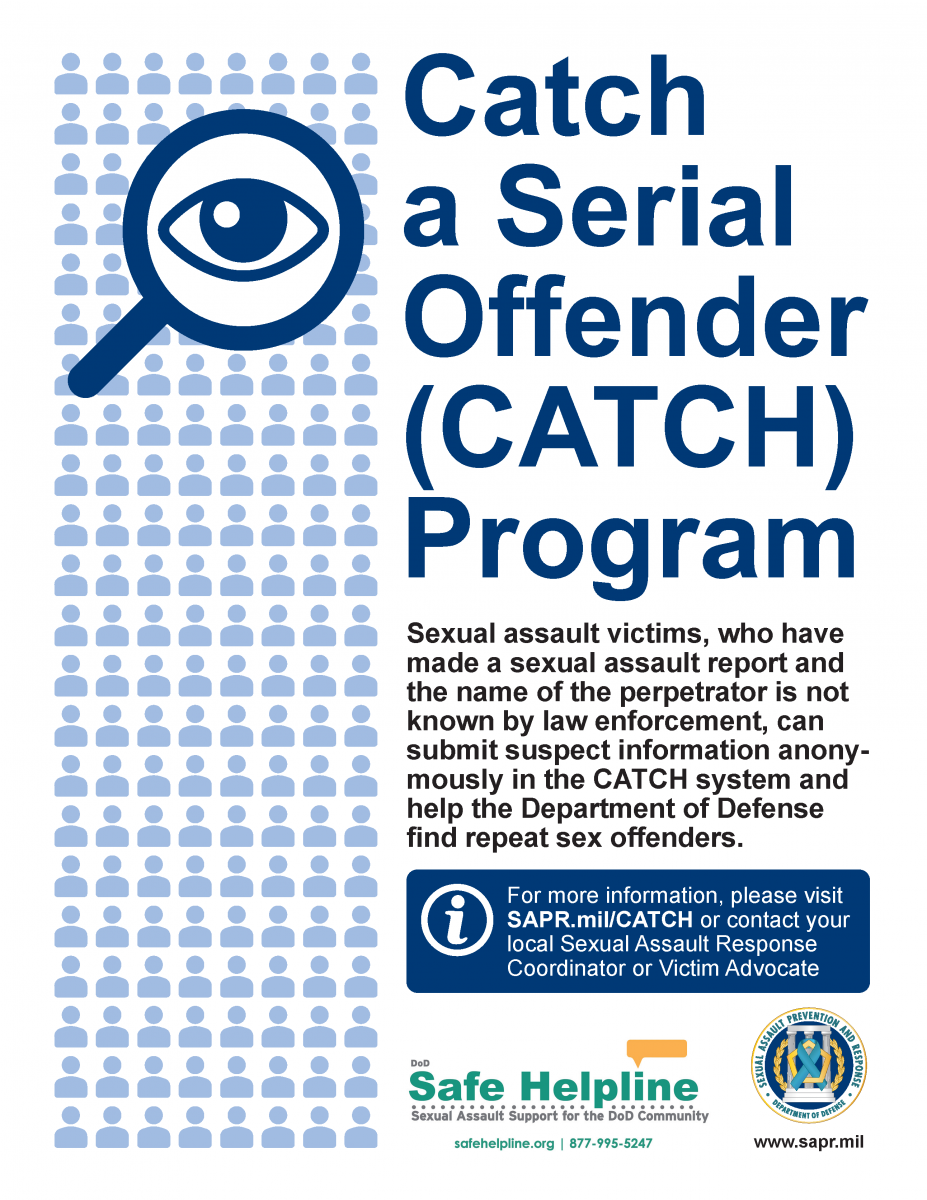 |
 |
| Eligibility Expansion and CATCH Website Updates
Learn more about expansion to eligibility to include certain Unrestricted Reporters and the latest CATCH system updates. |
CATCH Program Procedures
Understand important program information by referencing the CATCH Program procedures. |
CATCH Program Poster
Promote awareness of the CATCH Program at your installation by printing and posting the CATCH poster. |
CATCH Program Talking Points for SARCs
SARCs and SAPR Victim Advocates should use the attached “SARC CATCH Talking Points” when explaining the CATCH Program to sexual assault victims and when providing notification to a victim after a “match” in the CATCH website. |
 |
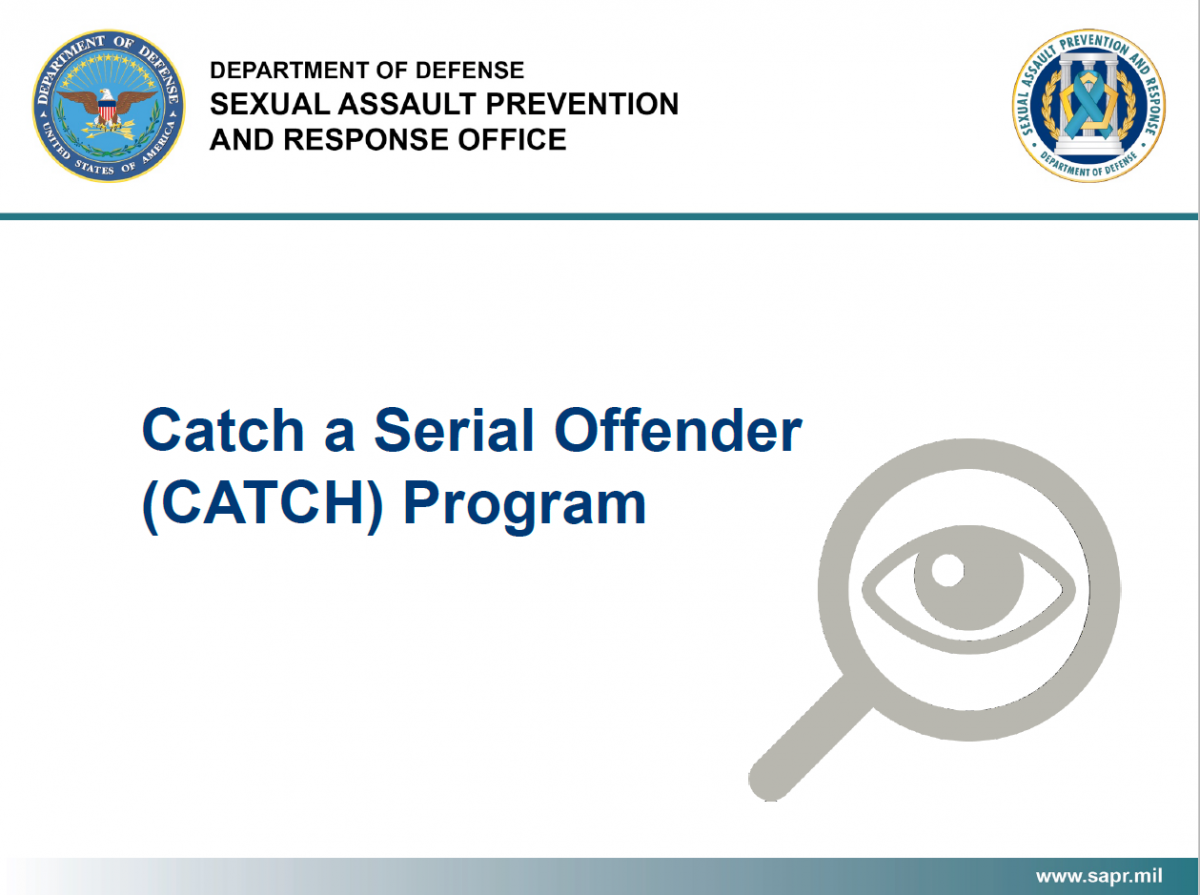 |
||
| Official CATCH Program Website for Victim Entries
Click here to access the official CATCH Program website where eligible sexual assault victims can make an entry using the Username and Password provided by the SARC. Before you get to the entry submission page that requires a Username and Password, you can review the "Landing Page" for general information of the CATCH Program, info for victims on "Getting Started", "FAQs", and a "Privacy Notice" |
DD Form 2910
All the CATCH-related information (initial information for victim to submit an entry –and- documentation of post-match notification) now appears in p.3 of the DD Form 2910. Also included is the link to the CATCH information on sapr.mil/catch |
CATCH 101 PowerPoint
Gain an understanding of the CATCH Program overview, key roles, program procedures, and additional resources with this short slide deck. |
- How do I make a CATCH entry?
-
Visit the CATCH Program website on your computer or mobile device at a time that's convenient. Your SARC can provide you the web address and your personal, anonymous, secure log-in information.
- Do I have to provide my name?
-
No, you cannot share your name; the process is anonymous.
- What information do you need about the suspect?
-
You can provide as much information as you can remember and feel comfortable sharing (for example, name, rank, height, tattoos or other distinguishing factors), or any other information you think may be important in identifying the suspect, or linking the suspect to other crimes.
- How long do you keep my entry in the CATCH system?
-
Each entry is kept for 10 years. This means that you could be contacted at any time over the next 10 years if there is a potential match, as long as you don't opt out and your contact information doesn't change.
- What about my Sexual Assault Forensic Examination (SAFE) Kit?
-
The SAFE Kit corresponding to your Restricted Report will be retained for 10 years in order to avoid the unintended destruction of a Restricted Reporting SAFE Kit affiliated with a CATCH entry.
- How will I be contacted if there is a potential match?
-
You will be contacted privately, using ONLY the information you provided. Your name and information will remain anonymous until you decide to participate in an investigation and convert your Restricted Report to Unrestricted. You can always say you don't want to participate.
- What if I change my mind, can I opt out of the CATCH Program once I've made my entry?
-
Yes, you can opt out at any time - just tell your SARC.
- If a victim who previously filed a Restricted Report hears about the CATCH Program and now wants to submit a CATCH entry, do they have to fill out a new DD Form 2910 with the CATCH notifications and victim's contact information? (See highlighted areas in the attached 2910 to see where the new CATCH information is located)
-
Yes, but the victim does not need to fill out a new 2910 in its entirety.
Step 1: The SARC should retrieve the original 2910 to obtain the DSAID Control Number.
Step 2: That DSAID Control number should then be placed on the new 2910 form, but the victim ONLY needs to fill out the CATCH-related questions on the new form and sign it. The rest of the 2910 is left blank.
Step 3: The SARC should then scan in both the old and new 2910s together and upload them into the DSAID File Locker.
- If a victim uses their own computer to enter information in the CATCH system, is their IP address captured?
-
The CATCH database is a secure database and does not capture IP addresses.
- What if a victim inadvertently provides information in the CATCH database that makes them identifiable (i.e., says the offender is their supervisor and provides the name of the supervisor on the form)? Will they have to convert to an Unrestricted Report?
-
A CATCH participant will only convert to an Unrestricted Report by electing to convert their case.
- Who will the other CATCH Program POCs be? Victims may want to know who is going to see their entries.
-
Information contained in the database is visible only to specially-designated MCIOs assigned to CATCH headquarters by each Service. There is no identifying information contained in the database to match an entry to the victim.
- If a victim has elected the Unrestricted Reporting option, but does not wish to participate in the investigation, are they able to provide information via the CATCH database?
-
No. Only those victims that elect the Restricted Reporting option are eligible to participate in the CATCH Program. However, all CATCH entries are run against open and closed Unrestricted Reports.
- Can a victim of sexual assault who has left the Service still participate in the CATCH Program?
-
Victims who are eligible to participate in the CATCH Program are adult sexual assault victims (i.e., Service members, Military Service Academy cadets and midshipmen, and their adult dependents) who have filed a Restricted Report. Former Service members and their adult dependents who filed a Restricted Report while in the service are also eligible for the CATCH Program.
- Can a victim who receives VA benefits for military sexual trauma report their assault in CATCH?
-
If the veteran receiving MST benefits made a Restricted Report during their military service, they may contact any SARC from their Military Branch to ask about participating in CATCH. To locate the nearest SARC, click here.
If the veteran did not make a Restricted Report while in the Service, Department policy does not currently allow them to make a Restricted Report. Retirees and separated members may only make an Unrestricted Report at this time.
- What are the requirements for a victim who wants to mail in a hardcopy of their CATCH form?
-
To do this, the SARC should print out an official form with a serial number for the victim to fill in and provide them with the CATCH Program headquarters mailing address. The SARC should make sure that if a victim wants to mail in a form, they are given the official form with the Victim Report Number on it.
- What happens when a person who participated in CATCH transfers?
-
There is no change. If there is a match, the victim will be contacted by the CATCH POC designated by their Service.
- If a victim transfers and signs the DD Form 2910 agreeing to transfer their case, is there a place on the DD Form 2910 to update contact information for CATCH notification purposes?
-
When filing a CATCH entry, the victim is asked to provide permanent contact information, as a match may occur in the future, after which they may have transferred or even left the military.
- What should a SARC do if they have an issue with their account and can’t access their username and password?
-
If SARCs have problems accessing their accounts their first action should to reach out to their administrator to see if their account is in an "inactive" status. Between 31 to 44 days the accounts go inactive but can be reactivated by an Admin. At the 45-day mark accounts are disabled and an IT ticket will need to be submitted to NCIS headquarters to have the account re-established. This ticket or call must come from the Service SAPR Program Manager or Service CATCH Admin and must include the user’s first name, last name, role, Service, and your DoD ID number located on the back of your CAC.
For other CATCH IT issues, call NCIS IT support: 571-305-9999, option 2
(Important: This line is for SARCs only and not intended for victims. It may be answered by law enforcement and could compromise a Restricted Report.)
- What is the role of a Special Victims’ Counsel if there is a match in the CATCH system?
-
The Special Victims’ Counsel/Victims’ Legal Counsel (SVC/VLC) will assist the victim in getting answers to questions related to the investigation or legal process.
- What are the requirements for a victim who wants to submit a photo?
-
Unfortunately, victims are unable to upload a digital photo to the CATCH system at this time. However, they can mail one in. The SARC can provide a mailing address for this purpose but cannot mail this in for the victim. The SARC should ask the victim to mark the photo with the Restricted Reporting DSAID Control Number. Additionally, to maintain the victim’s anonymity, the SARC will caution the victim to place the SARC address as the return address. The victim cannot place their own name and address on the envelope.
- If a victim who previously filed a Restricted Report hears about the CATCH Program and now wants to submit a CATCH entry, do they need to fill out a new DD Form 2910 with the CATCH notifications and victim's contact info?
-
Answer: Yes, but the victim does not need to fill out a new 2910 in its entirety.
Step 1: The SARC should retrieve the original 2910 to obtain the DSAID Control Number.
Step 2: That DSAID Control number should then be placed on the new 2910 form, but the victim ONLY needs to fill out the CATCH-related questions on the new form and sign it. The rest of the 2910 is left blank.
Step 3: The SARC should then scan in both the old and new 2910s together and upload them into the DSAID File Locker.
- I have more questions. Who can I speak with before deciding?
-
If you are eligible, your SARC or SAPR Victim Advocate can offer you a referral to a Special Victims' Counsel (Army, Air Force, National Guard) or Victims' Legal Counsel (Navy, USMC), who is your personal attorney (not a prosecutor or a defense attorney). They can help answer your legal questions about the CATCH program.
